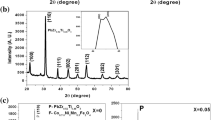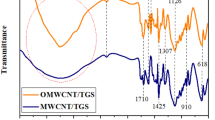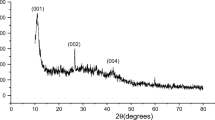Abstract
The present work reports anomalous ferroelectric properties of two nanocomposites containing oxidized multiwalled carbon nanotubes (ox-MWCNT) as an electrically conductive filler combined with each of hydrogen-bonded ferroelectrics of potassium dihydrogen phosphate (KDP) and triglycine sulfate (TGS). It was shown that the influence of ox-MWCNT led to the anomalous increase in a phase transition point, domain-wall freezing temperatures and coercive fields in ferroelectric parts of the composites. The OH radicals equipped on the carbon nanotube surface after oxidation were responsible for the observed anomalies.









Similar content being viewed by others
Data availability
All data generated or analyzed during this study are included in this published article.
References
D. Baohui, S.U. Mu Haq, S.H. Din, S. Wenyi, W. Jingmin, C. Hanwen, Z. Ye, L. Zhu, Low-temperature monitoring of SF6 decomposition products based on CeO2@MWCNTs composite sensor. J. Alloys Compd. (2022). https://doi.org/10.1016/j.jallcom.2022.165192
B. Zhou, C. Li, Y. Zhou, Z. Liu, X. Gao, X. Wang, L. Jiang, M. Tian, F.-L. Zhou, S. Jerrams, J. Yu, A flexible dual-mode pressure sensor with ultra-high sensitivity based on BTO@MWCNTs core-shell nanofibers. Compos. Sci. Technol. 224, 109478 (2022). https://doi.org/10.1016/j.compscitech.2022.109478
J.H. Liu, L. Saravanan, H.Y. Miao, L.C. Wang, Investigation of microwave absorption properties of multiwalled nanotube buckypaper filled with cobalt nanoparticles. Mater. Res. Innov. (2014). https://doi.org/10.1179/1432891714Z.000000000590
T.I.T. Kudin, N.F.A. Zainal, A.M.M. Ali, S. Abdullah, M. Rusop, M.A. Sulaiman, M.Z.A. Yahya, Electrochemical performance of anode material from palm oils derived carbon nanotubes for lithium ion batteries. Mater. Res. Innov. 13, 269–271 (2009). https://doi.org/10.1179/143307509X440497
I. Butnaru, A.P. Chiriac, C.P. Constantin, M.D. Damaceanu, Insights into MWCNTs/polyimide nanocomposites: from synthesis to application as free-standing flexible electrodes in low-cost micro-supercapacitors. Mater. Today Chem. 23, 100671 (2022). https://doi.org/10.1016/j.mtchem.2021.100671
T. Ambreen, A. Saleem, M.K.A. Tanveer, S.A. Shehzad, C.W. Park, Irreversibility and hydrothermal analysis of the MWCNTs/GNPs-based nanofluids for electronics cooling applications of the pin-fin heat sinks: Multiphase Eulerian-Lagrangian modeling. Case Stud. Therm. Eng. 31, 101806 (2022). https://doi.org/10.1016/j.csite.2022.101806
Z. Špitalský, C.A. Krontiras, S.N. Georga, C. Galiotis, Effect of oxidation treatment of multiwalled carbon nanotubes on the mechanical and electrical properties of their epoxy composites. Compos. Part A Appl. Sci. Manuf. 40, 778–783 (2009). https://doi.org/10.1016/j.compositesa.2009.03.008
L. Lavagna, M. Bartoli, D. Suarez-Riera, D. Cagliero, S. Musso, M. Pavese, Oxidation of carbon nanotubes for improving the mechanical and electrical properties of oil-well cement-based composites. ACS Appl. Nano Mater. 5, 6671–6678 (2022). https://doi.org/10.1021/acsanm.2c00706
H. Haruna, M.E. Pekdemir, A. Tukur, M. Coşkun, Characterization, thermal and electrical properties of aminated PVC / oxidized MWCNT composites doped with nanographite. J. Therm. Anal. Calorim. 139, 3887–3895 (2020). https://doi.org/10.1007/s10973-019-09184-7
S. Liang, G. Li, R. Tian, Multi-walled carbon nanotubes functionalized with a ultrahigh fraction of carboxyl and hydroxyl groups by ultrasound-assisted oxidation. J. Mater. Sci. 51, 3513–3524 (2016). https://doi.org/10.1007/s10853-015-9671-z
M.R. Mahdavi, M. Delnavaz, V. Vatanpour, Fabrication and water desalination performance of piperazine–polyamide nanocomposite nanofiltration membranes embedded with raw and oxidized MWCNTs. J. Taiwan Inst. Chem. Eng. 75, 189–198 (2017). https://doi.org/10.1016/j.jtice.2017.03.039
D. Prasad, K.N. Patil, N. Sandhya, C.R. Chaitra, J.T. Bhanushali, A.K. Samal, R.S. Keri, A.H. Jadhav, B.M. Nagaraja, Highly efficient hydrogen production by hydrolysis of NaBH4 using eminently competent recyclable Fe2O3 decorated oxidized MWCNTs robust catalyst. Appl. Surf. Sci. 489, 538–551 (2019). https://doi.org/10.1016/j.apsusc.2019.06.041
M. Bhaumik, S. Agarwal, V.K. Gupta, A. Maity, Enhanced removal of Cr(VI) from aqueous solutions using polypyrrole wrapped oxidized MWCNTs nanocomposites adsorbent. J. Colloid Interface Sci. 470, 257–267 (2016). https://doi.org/10.1016/j.jcis.2016.02.054
M. Pei, J. Guo, B. Zhang, H. Wang, Y. Zhu, Q. Wang, K. Tsukagoshi, Y. Shi, Y. Li, Splitting charge injection for ultrahigh on/off ratio in a floating-metal-gated planar organic ferroelectric memory. Mater. Today Energy 21, 100711 (2021). https://doi.org/10.1016/j.mtener.2021.100711
E. Li, X. Wu, Q. Chen, S. Wu, L. He, R. Yu, Y. Hu, H. Chen, T. Guo, Nanoscale channel organic ferroelectric synaptic transistor array for high recognition accuracy neuromorphic computing. Nano Energy 85, 106010 (2021). https://doi.org/10.1016/j.nanoen.2021.106010
K. Wang, H. Zhu, J. Ouyang, Y. Tian, S. Wang, Q. Li, Y.-Y. Zhao, H. Cheng, X. Zhai, Significantly improved energy storage stabilities in nanograined ferroelectric film capacitors with a reduced dielectric nonlinearity. Appl. Surf. Sci. 581, 152400 (2022). https://doi.org/10.1016/j.apsusc.2021.152400
S. Mohammadi, A. Khodayari, P. Mohammadi, Performance enhancement of cylindrical ferroelectric transducers. Ceram. Int. 40, 87–91 (2014). https://doi.org/10.1016/j.ceramint.2013.05.107
R. Irzaman, R.P. Siskandar, H. Jenie, M. Syafutra, B. Iqbal, M.Z. Yuliarto, Fahmi, ferdiansjah, khairurrijal: ferroelectric sensor BaxSr1-xTiO3 integrated with android smartphone for controlling and monitoring smart street lighting. J. King Saud Univ. Sci. 34, 102180 (2022). https://doi.org/10.1016/j.jksus.2022.102180
X. Gou, Y. Liu, N. Jiang, Y. Li, Y. Jiang, J. Chen, Z. Tang, Y. Bai, S. Zhao, Non–ferroelectric intercalation structure based on aurivillius phase Bi4Ti3O12: a research arena to achieve high energy storage performance. Ceram. Int. 48, 9534–9543 (2022). https://doi.org/10.1016/j.ceramint.2021.12.151
B. Deepa, P. Philominathan, Enhanced NLO and antibacterial properties of nicotinic acid-doped KDP crystals: synthesis, growth and characterisation. Mater. Res. Innov. 21, 86–90 (2017). https://doi.org/10.1080/14328917.2016.1191794
M. Anis, D.A. Hakeem, G.G. Muley, Optical and dielectric studies of KH2PO4 crystal influenced by organic ligand of citric acid and l-valine: A single crystal growth and comparative study. Results Phys. 6, 645–650 (2016). https://doi.org/10.1016/j.rinp.2016.09.001
S. Reyné, G. Duchateau, J.-Y. Natoli, L. Lamaignère, Laser-induced damage of KDP crystals by 1ω nanosecond pulses: influence of crystal orientation. Opt. Express 17, 21652–21665 (2009). https://doi.org/10.1364/OE.17.021652
M. Banan, R.B. Lal, A. Batra, Modified triglycine sulphate (TGS) single crystals for pyroelectric infrared detector applications. J. Mater. Sci. 27, 2291–2297 (1992). https://doi.org/10.1007/BF01105034
P.R. Deepthi, A. Sukhdev, P.M. Kumar, V.J. Angadi, U.M. Pasha, J. Shanthi, Structural, FTIR and Ferro electric analysis of pure TGS and L-Cysteine doped TGS crystals for infrared device applications. Chem. Data Collect. 17–18, 276–286 (2018). https://doi.org/10.1016/j.cdc.2018.09.007
O. Boni, S. Berger, Dielectric properties of kdp filled porous alumina nanocomposite thin films. J. Nanosci. Nanotechnol. 1, 433–439 (2001). https://doi.org/10.1166/jnn.2001.061
O.M. Golitsyna, S.N. Drozhdin, V.N. Nechaev, A.V. Viskovatykh, V.M. Kashkarov, A.E. Gridnev, V.V. Chernyshev, Dielectric properties of porous aluminum and silicon oxides with inclusions of triglycine sulfate and its modified analogs. Phys. Solid State. 55, 529–535 (2013). https://doi.org/10.1134/S1063783413030128
B.D. Mai, H.T. Nguyen, D.H. Ta, A.S. Sidorkin, S.D. Milovidova, Preparation and dielectric properties of a mixed ferroelectric composite from nanoparticles of cellulose and triglycine sulfate. Ferroelectrics 543, 175–183 (2019). https://doi.org/10.1080/00150193.2019.1592431
H.T. Nguyen, P.T.B. Thao, Influence of moisture on ferroelectric–paraelectric phase transition of a composite containing oxidized MWCNT and TGS. Ferroelectr. Lett. Sect. 48, 13–19 (2021). https://doi.org/10.1080/07315171.2021.1923116
Y.N. Huang, X. Li, Y. Ding, Y.N. Wang, H.M. Shen, Z.F. Zhang, C.S. Fang, S.H. Zhuo, P.C.W. Fung, Domain freezing in potassium dihydrogen phosphate, triglycine sulfate, and CuAlZnNi. Phys. Rev. B. 55, 16159–16167 (1997). https://doi.org/10.1103/PhysRevB.55.16159
S.A. Gridnev, L.A. Shuvalov, V.V. Gorbatenko, B.N. Prasolov, “Freezing” of domain structure in Rb2ZnCl4. Ferroelectrics 140, 145–149 (1993). https://doi.org/10.1080/00150199308008277
H.T. Nguyen, M.T. Chau, Structural and dielectric studies of three-phase composite containing multiwalled carbon nanotubes, nanodispersed silica and KDP. Phase Transit. 93, 1080–1088 (2020). https://doi.org/10.1080/01411594.2020.1839753
J. Tao, S.-A. Cao, Flexible high dielectric thin films based on cellulose nanofibrils and acid oxidized multi-walled carbon nanotubes. RSC Adv. 10, 10799–10805 (2020). https://doi.org/10.1039/C9RA10915C
W.-L. Song, M.-S. Cao, B. Wen, Z.-L. Hou, J. Cheng, J. Yuan, Synthesis of zinc oxide particles coated multiwalled carbon nanotubes: dielectric properties, electromagnetic interference shielding and microwave absorption. Mater. Res. Bull. 47, 1747–1754 (2012). https://doi.org/10.1016/j.materresbull.2012.03.045
D. Vorontsov, S. Filonenko, A. Kanak, G. Okrepka, Y. Khalavka, Charge directed assembly of CdTe/CdS nanoparticles inside monocrystalline KH2PO4. CrystEngComm 19, 6804–6810 (2017). https://doi.org/10.1039/C7CE01688C
R.M. Hill, S.K. Ichiki, Infrared absorption by hydrogen bonds in single crystal KH2PO4, KD2PO4, and KH2AsO4. J. Chem. Phys. 48, 838–842 (1968). https://doi.org/10.1063/1.1668722
N. Sinha, S. Bhandari, H. Yadav, G. Ray, S. Godara, N. Tyagi, J. Dalal, S. Kumar, B. Kumar, Performance of crystal violet doped triglycine sulfate single crystals for optical and communication applications. CrystEngComm 17, 5757–5767 (2015). https://doi.org/10.1039/C5CE00703H
U. Straube, H. Beige, Nonlinear electromechanical behaviour of KDP near its phase transition. J. Alloys Compd. 310, 181–183 (2000). https://doi.org/10.1016/S0925-8388(00)00943-9
M. Trybus, Phase transition in triglycine sulphate investigated using two-phase bridge measurements. Infrared Phys. Technol. 109, 103409 (2020). https://doi.org/10.1016/j.infrared.2020.103409
S.T. Liu, J.D. Zook, Evaluation of curie constants of ferroelectric crystals from pyroelectric response. Ferroelectrics 7, 171–173 (1974). https://doi.org/10.1080/00150197408237985
D.-H. Kim, J.-J. Kim, Dynamic scaling of hysteresis loop areas in ferroelectric KDP crystal. Ferroelectrics 222, 285–293 (1999). https://doi.org/10.1080/00150199908014828
H.V. Alexandru, C. Berbecaru, F. Stanculescu, L. Pintilie, I. Matei, M. Lisca, Doped TGS crystals for IR detection and sensors. Sens. Actuators A Phys. 113, 387–392 (2004). https://doi.org/10.1016/j.sna.2004.03.046
H.T. Nguyen, A.S. Sidorkin, S.D. Milovidova, O.V. Rogazinskaya, Investigation of dielectric relaxation in ferroelectric composite nanocrystalline cellulose – triglycine sulfate. Ferroelectrics 498, 27–35 (2016). https://doi.org/10.1080/00150193.2016.1166835
D. Michel, Test of the formal basis of Arrhenius law with heat capacities. Phys. A Stat. Mech. Appl. 510, 188–199 (2018). https://doi.org/10.1016/j.physa.2018.06.125
A. Rajani Malathi, V.J. Usha Praveena, M. Sundara Murthy, G. Prasad, Vogel Fulcher analysis of electrical studies of NBT-CT ceramic composites. Mater. Today Proc. 59, 449–458 (2022). https://doi.org/10.1016/j.matpr.2021.11.462
N.M. Galiyarova, Critical slowing down of relaxing domain walls and interfaces in phase transition vicinities. Ferroelectrics 170, 111–121 (1995). https://doi.org/10.1080/00150199508014197
A. Feisst, P. Koidl, Current induced periodic ferroelectric domain structures in LiNbO3 applied for efficient nonlinear optical frequency mixing. Appl. Phys. Lett. 47, 1125–1127 (1985). https://doi.org/10.1063/1.96349
Funding
This study received no funding.
Author information
Authors and Affiliations
Contributions
The author HTN contributed to conducting experiments, analyzing data and preparing the manuscript.
Corresponding author
Ethics declarations
Conflict of interests
The author declares that no conflict of interest exists related to the paper entitled “Anomalous ferroelectricity in nanocomposites from hydrogen-bonded ferroelectrics with oxidized MWCNT”. The author declares that the paper is not being under consideration by another journal and has not been published yet.
Ethical approval
The author declare that the materials used in all experiments for the study entitled “Anomalous ferroelectricity in nanocomposites from hydrogen-bonded ferroelectrics with oxidized MWCNT” were not related to human and animals.
Additional information
Publisher's Note
Springer Nature remains neutral with regard to jurisdictional claims in published maps and institutional affiliations.
Rights and permissions
Springer Nature or its licensor (e.g. a society or other partner) holds exclusive rights to this article under a publishing agreement with the author(s) or other rightsholder(s); author self-archiving of the accepted manuscript version of this article is solely governed by the terms of such publishing agreement and applicable law.
About this article
Cite this article
Nguyen, H.T. Anomalous ferroelectricity in nanocomposites from hydrogen-bonded ferroelectrics with oxidized MWCNT. Appl. Phys. A 128, 1032 (2022). https://doi.org/10.1007/s00339-022-06172-x
Received:
Accepted:
Published:
DOI: https://doi.org/10.1007/s00339-022-06172-x




